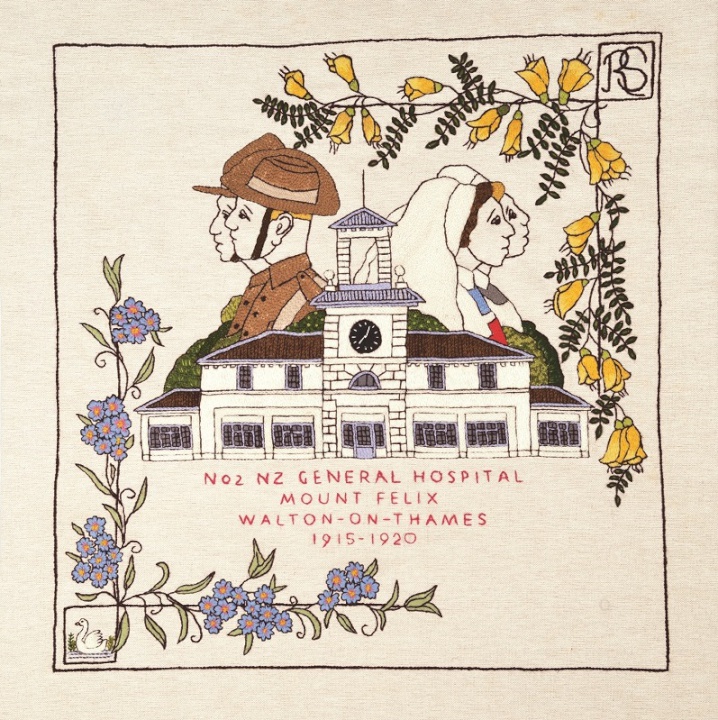History in stitches at Canterbury Museum
History in stitches at Canterbury
Museum

An embroidered tapestry
commemorating the Kiwi connection an English community
forged during World War One will be displayed at Canterbury
Museum from 6 October to 3 November.
Between July 1915 and March 1920, 27,000 New Zealand soldiers were treated at the No 2 New Zealand General Hospital at the Mount Felix estate in the English town of Walton-on-Thames.
A century later, Walton-on-Thames residents worked together to create the tapestry as a tribute to the ANZAC soldiers, nurses, doctors and the people of Walton 100 years ago.
The community tapestry project, organised by the Riverhouse Barn Arts Centre in Walton, was launched in April 2015 and completed in April 2017. Designed by Andrew Crummy, the tapestry tells stories of bravery, love and loss from the hospital.
Over the 2 years a small army of stitchers from around the area, and some in New Zealand, created the 44 panels of the tapestry.
One of the panels illustrates the incredible bravery displayed by Kaikōura-born nurse Edith "Poppy" Popplewell when the HMT Marquette was sunk by a German torpedo on 23 October 1915.
Christchurch nurse, Kate Paterson, worked on this panel along with descendants of Hugh Acland, who survived the sinking and nurse Lorna Rattray who did not. Hugh Acland also features in a panel as he was president of the hospital’s medical board from 1917.
Paterson was asked to take part in the project by the committee of the historic Christchurch Nurses Memorial Chapel because of her connection to both the chapel and the Canterbury Embroiderers' Guild. The chapel was built in 1928 to commemorate the New Zealand nurses who lost their lives in World War One – including in the Marquette sinking – and the subsequent influenza epidemic.
Lance Corporal Alexander Grant from Invercargill first spotted his future wife, Walton-on-Thames resident Ruth Rosewell, over an “ivy clad wall” while recovering from a war wound at the hospital. Their romance is the subject of another of the tapestry’s panels.
Canterbury Museum Director Anthony Wright says the Mount Felix Tapestry is a unique way of commemorating the special connections between Walton-on-Thames and New Zealand.
“It really is remarkable that a century after the War, the Walton community still feel such a strong connection to New Zealand. The New Zealanders must have made quite an impression when they were there!
“We’re very pleased to have this beautiful tapestry here at the Museum, particularly because it so brilliantly complements our own exhibition, Canterbury and World War One: Lives Lost, Lives Changed.”
The Mount Felix Tapestry is
currently touring New Zealand and will be displayed in
Canterbury Museum’s Visitor Lounge from 6 October to 3
November.
Listing
text:
The Mount Felix Tapestry, a 44-panel embroidered tapestry telling stories of bravery, love and loss from the No 2 New Zealand General Hospital in Walton-on-Thames, England, is on display at Canterbury Museum.
Over 27,000 wounded and sick Kiwi soldiers were treated at the hospital between 1915 and 1920.
The tapestry was created by members of the Walton community, with help from New Zealand stitchers. It commemorates the town’s Kiwi connection and is a tribute to the ANZAC soldiers, nurses, doctors and the people of Walton 100 years ago.
The Mount Felix tapestry is on display In the Museum’s Visitor Lounge on Level 3 from 6 October to 3 November.
ends


 Water Safety New Zealand: Don’t Drink And Dive
Water Safety New Zealand: Don’t Drink And Dive NZ Olympic Committee: Lydia Ko Awarded Lonsdale Cup For 2024
NZ Olympic Committee: Lydia Ko Awarded Lonsdale Cup For 2024 BNZ Breakers: BNZ Breakers Beaten By Tasmania Jackjumpers On Christmas Night
BNZ Breakers: BNZ Breakers Beaten By Tasmania Jackjumpers On Christmas Night Te Whatu Ora Health NZ: Health Warning – Unsafe Recreational Water Quality At Roto Kohatu Reserve At Lake Rua
Te Whatu Ora Health NZ: Health Warning – Unsafe Recreational Water Quality At Roto Kohatu Reserve At Lake Rua Shearing Sports NZ: Shearing Them Around - 11 Shearing Records In 2024
Shearing Sports NZ: Shearing Them Around - 11 Shearing Records In 2024 The New Zealand Retro: Special End Of Year Retro Chart Show On Independent Radio Stations
The New Zealand Retro: Special End Of Year Retro Chart Show On Independent Radio Stations